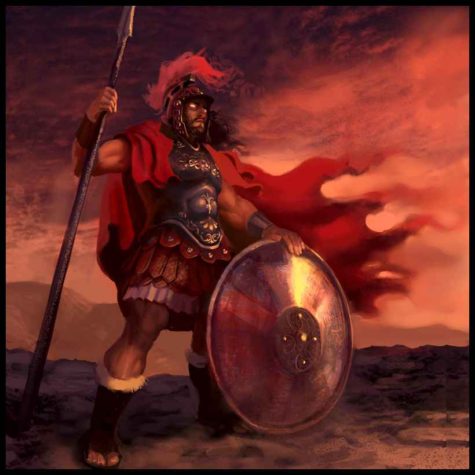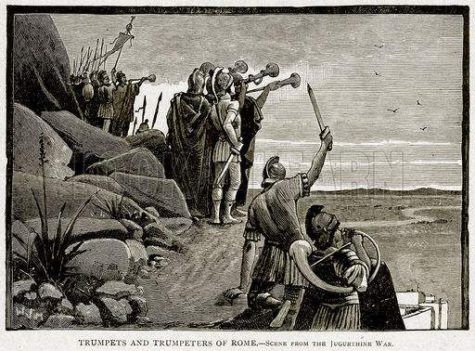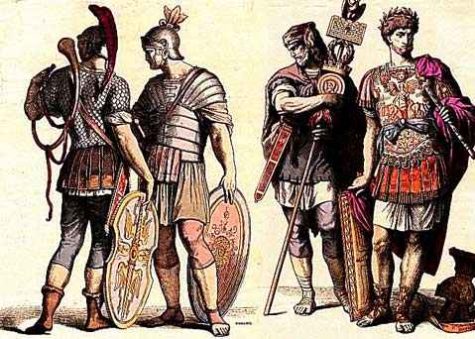War
“You’re right to come, Marcher; your days demand their place
and the month that bears your stamp is here.”
~Ovid
March (Martius), the first month of the lunar calendar, was named after Mars and the entire month was dedicated to Him. The festivals reflected a purification and regeneration of the arms and fields, marking a time when farmers had to think of cultivating and protecting their lands. The efficacy of Mars’ divine aid was much needed in preparation for the seasonal crop growth and upcoming military campaigns, as wars often began or were renewed in the spring.
March 1st was the lunar calendar’s New Year’s Day, and may have also been Mars’ birthday. The festival of Quinquatrus (named for its length of five consecutive days) commenced on 19 March when the ancilia of the Salii and the weapons of the whole army were purified.
On 23 March, the Romans venerated Mars during the Tubilustrium, a cleansing ceremony for the trumpets used in sacred rites and the instruments of the entire army. A subsequent purification rite was performed on 19 October during the Armilustrium, and the Salii, commemorating the return of the legions in the fall, made their final procession through the streets of Rome. It signified the end of the military campaign season when arma (arms) and ancilia were purified and laid to rest for the winter.
How do we relate to Mars this month?
With Mars, there is no contemplation before action. The drive associated with Mars differs from that of the Sun in that it is self-assertion rather than assertion of the will; it is raw energy rather than creative energy.
Mars is still the essence of the god from antiquity. He is still the captivating aggressor, the rouser, and the protagonist of destiny; breathtakingly candid in His purpose and deliberate in His bounty. Mars personifies a vigorous energy that carries with it its own reproductive weight, immersed in singular ambition, and seldom outdone. He is the quintessential model of male sexuality; the catalyst for creation Who leaves little doubt that our perpetuation is imminent and our survival inevitable. Yet His artful passion is lucid; a flowing expression steeped in honorific intent and delivered with remarkably unbiased conveyance.
The expression of our basic needs remains the one true constant among all living beings. When we peel back the layers of aspirations and ideals, we reach the crux of the human race with uncanny fidelity; the instinctual drives that have served us so well. It is here, at this center that we find Mars, ceaselessly reminding us that no matter how far we venture from this place, the road back is always nearer than we realize.
How do we honor Mars this month?
Mars represents the instinctive nature still evident in all species: that of survival and protection. In antiquity, Mars’ reigning aspects were interwoven into a society that understood a definable application of pursuit and preservation. The Romans recognized the necessity of this sequence as the occurring truth behind any deliberate progress. These enduring principles are at the very heart of Perpituitas; qualities attributed to our role as the caretakers of our posterity.
In His warrior aspect we associate Mars with iron, but an iron will is of the same caliber. Protection has always been our gift to those we love, and a duty to ourselves. Though we no longer spend our days in the fields, the fruits of our labors still determine the quality of our life.
Pray to Mars when you need to shift into another gear, to bring your purpose from wishful pondering to fruition and culmination. Look to Mars when your spirit needs reawakening and you find yourself lost in the cycle of delay, needing to summon up the courage to act. When the mundane begins to chisel your determination into quiet resignation, let Mars hear your call to arms. His still powerful voice speaks volumes to all who listen. Mars continues to provoke and ignite while craftily providing us with His earthly wisdom; those universal gifts of our own nature which allow us to fully embrace our life’s experience and remain secure in our duration.
Source: Religioromana
Originally Armistice Day, commemorating the signing of the agreement that ended World War I at 11:00 A.M., November 11, 1918. An act approved May 13, 1938 made November 11 a legal Federal holiday, “dedicated to the cause of world peace and to be hereafter celebrated and known as ‘Armistice Day.’”
This federal holiday was changed to Veterans Day in 1954. At that time, it became a day to honor all the men and women who have served in the armed forces of the United States. Each year, special ceremonies are held at Arlington National Cemetery in Virginia.
An official wreath-laying ceremony is held each Veterans Day at the Tomb of the Unknown Soldier in Arlington National Cemetery, while parades and other celebrations are held in states around the country.
Veterans Day is not to be confused with Memorial Day—a common misunderstanding, according to the U.S. Department of Veterans Affairs. Memorial Day (the fourth Monday in May) honors American service members who died in service to their country or as a result of injuries incurred during battle, while Veterans Day pays tribute to all American veterans—living or dead—but especially gives thanks to living veterans who served their country honorably during war or peacetime.
Consider spending some time on-line learning more about our nation’s veterans.
- The Great War Society has developed a Web site devoted to World War I educational materials.
- The World War II Memorial celebrates the victory of “the greatest generation” with a design that uses moving water to harmonize with its natural surroundings.
- Visit the Korean War Veterans Memorial online; this moving memorial, dedicated in 1995, is the latest addition to the National Mall in Washington, D.C.
- See a registry of all the names on the Vietnam Veterans Memorial Wall in Washington. Learn more about the military men and women who are on duty today.
Source: Almanac.com
The month of March was the traditional start of the campaign season, and the Tubilustrium was a ceremony to make the army fit for war. It was held on March 23, the last day of the Greater Quinquatrus (the festival of Mars and Minerva), and it occurred again on May 23.
The sacred trumpets (tubae) were originally war trumpets, but later they were used for ceremonial occasions. It is not clear if the army was involved, or if it was merely a ceremony to purify the trumpets used in summoning the assembly on the following day.
The ceremony was held in Rome in a building called the Hall of the Shoemakers (atrium sutorium) and involved the sacrifice of a ewe lamb. Romans who did not attend the ceremony would be reminded of the occasion by seeing the Salii dancing through the streets of the city.
Found at: Wikipedia
The Quinquatrus (March 19 through March 23) was named for the fact that it was the fifth day after the Ides (by the Roman method of inclusive counting), but popularly it came to be regarded as a five-day holiday in honor of Mars.
It marked the start of the traditional campaign season for the army. The day also became a feast day for Minerva, despite any clear link between the two deities. (The reason probably was that Minerva’s temple on the Aventine was dedicated on that day.) It seems that women were accustomed to consult fortune-tellers and diviners upon this day.
This primary festival of Minerva was mainly celebrated by artisans but also by students. Minerva, was the virgin goddess of poetry, medicine, wisdom, commerce, weaving, crafts, the arts, dyeing, magic, science, and the inventor of music. She is often depicted with her sacred creature, an owl, which symbolizes her ties to wisdom. March 23, Day of Artisans, is specifically dedicated to her.
 As Minerva Medica she is the patroness of physicians. Minerva is believed to be the inventor of numbers and musical instruments. She is thought to be of Etruscan origin, as the goddess Menrva or Menerva. Later she was equated with the Greek Athena and as such is also sometimes associated as a Goddess of war.
As Minerva Medica she is the patroness of physicians. Minerva is believed to be the inventor of numbers and musical instruments. She is thought to be of Etruscan origin, as the goddess Menrva or Menerva. Later she was equated with the Greek Athena and as such is also sometimes associated as a Goddess of war.
She is the daughter of Jupiter. In the temple on the Capitoline Hill she was worshiped together with Jupiter and Juno, with whom she formed a powerful triad of gods. Another temple of her was located on the Aventine Hill. The church of Santa Maria Sopra Minerva is built on one of her temples.
Source: Pantheon.org







